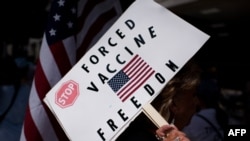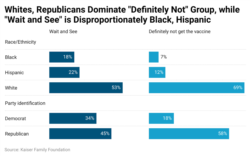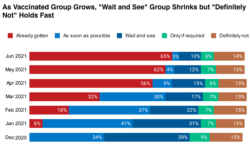Americans who say they will definitely not get vaccinated against COVID-19 are overwhelmingly white and Republican, according to polling by the Kaiser Family Foundation.
Meanwhile, the group that plans to wait and watch for problems is disproportionately Black and Hispanic.
The United States is falling just short of President Joe Biden's goal of having 70% of Americans receive at least one dose of vaccine by July 4.
While about one-third of Americans have not been immunized against COVID-19, their reasons and intentions break down largely along racial and political lines.
Hard no
Only 14% of Americans say they will definitely not get vaccinated. But this group is 69% white, compared with 7% Black and 12% Hispanic. Republicans make up 58% of this group, while Democrats account for 18%.
"From the beginning of the pandemic, we've seen political divides in attitudes towards COVID itself, not just the vaccines," said Liz Hamel, director of KFF's Public Opinion and Survey Research program.
For example, she said, "believing that the media has exaggerated the seriousness of the pandemic — that's something that we heard President [Donald] Trump saying when he was in office. It's something that Republicans are more likely to agree with than Democrats. And people who believe that the pandemic has been exaggerated are much less likely to say they want to get the vaccine."
More than half of those who said they would not get vaccinated said they did not need it.
Maybe later
On the other hand, KFF polling found that 10% of respondents said that they would "wait and see" before getting the shots.
The "wait and see" group is disproportionately Black (18%) and Hispanic (22%), compared with the "definitely not" group, where they make up 7% and 12%, respectively.
While the "definitely not" group is basically unchanged, the "wait and see" group has shrunk to a quarter of the size it was when vaccines began rolling out in December, as more and more people have gotten their shots.
But the number of people who still plan to wait and see seems to be leveling off. After big drops during the first couple of months of vaccine rollout, the "wait and see" group has lost just a few percentage points each month over the past several months.
While those who remain unvaccinated are increasingly hard to reach, experts say there are still opportunities to get more shots in arms.
Safety
The biggest reasons for hesitancy in all groups are the novelty of the vaccines and concerns about side effects.
All the vaccines currently in use are under emergency authorizations from the U.S. Food and Drug Administration, which has lower safety requirements than full FDA approval. About half of the "wait and see" group told KFF pollsters that they would be more likely to get the shots if they were FDA approved.
Health officials are working with trusted faith and community leaders, business owners, and others in communities with low vaccination rates. "We need these individuals to encourage their peers to accept the vaccine," said Rupali Limaye, head of behavioral and implementation science at the Johns Hopkins International Vaccine Access Center.
Some governments and businesses are offering incentives for people to get their shots, from free beer to million-dollar lotteries.
"Some people may be nudged by a free doughnut," Limaye said. "Others may require something larger, such as a chance for a college scholarship, for example."
Access is still an issue for some of the unvaccinated. In the KFF poll, 3% of people still said they planned to get vaccinated "as soon as possible."
Reaching this group may not sound like much of a gain, but "even an increase of one to two percent of vaccine coverage at the state level could really limit outbreaks," Limaye said.
Low-wage workers may be worried about finding time to schedule shots or recover from side effects.
Health officials could target Johnson & Johnson's one-shot vaccine for this group, Limaye said.
Employers could offer vaccines on the job, she added, and "they can also give employees time off to make sure that they can get the vaccine."
These measures may help motivate the "wait and see" group, KFF's Hamel said.
"There still is a lot of work to do in convincing those potentially convertible people before really worrying about how to convince people who ... are really strongly against getting the vaccine," she added.
KFF's most recent random-digit dial telephone survey reached 1,888 adults from June 8 to 21. The margin of error is 3%.







